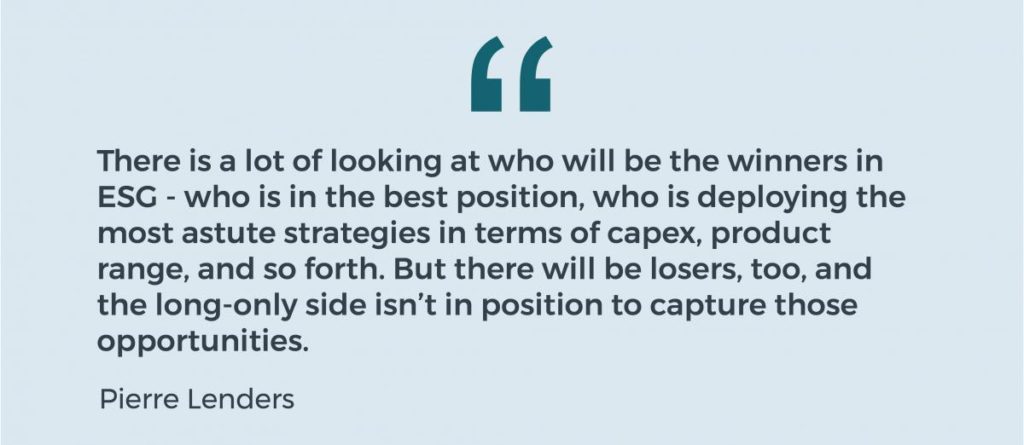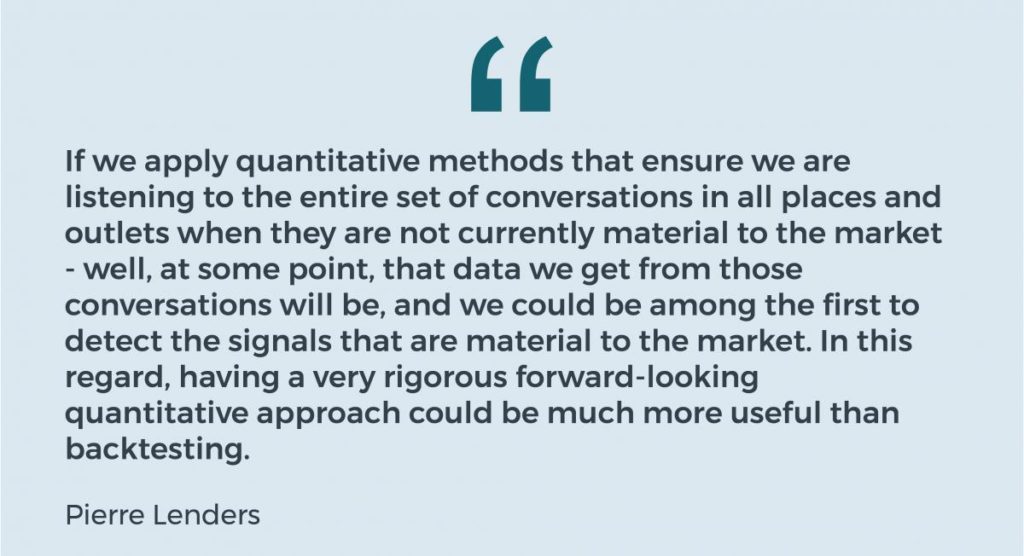This article was first published in Institutional Investor on 30 June 2020 here.
A renowned quant shop rolls out an absolute return innovation that isn’t just long-only.
There is no shortage of doubters when it comes to ESG investment strategies being a source of alpha, but it’s becoming more difficult to ignore that material ESG factors may boost company performance. That could be one reason why investors allocated $12.2 billion into ESG funds over the first four months of 2020, according to Morningstar Direct – more than double the amount directed into ESG funds over the same time period in 2019.
As the historically long bull market gave way to the Covid-19 crisis and recession, investors sought and found resilience in ESG funds. According to Bloomberg Intelligence, ETFs focused on companies with ESG practices that have earned them above-average marks outperformed through March 31, at which point 59% of U.S. ESG ETFs were doing better than the S&P 500 Index, and 60% of European ESG ETFs were beating the MSCI Europe Index. Performance data such as this lends some clarity to what was once a muddled ESG data picture, and contributes to the development of new ESG investment strategies.
“ESG used to be a compliance exercise,” says Pierre Lenders, Head of ESG, Capital Fund Management (CFM). “But today, to be a believable and trusted investment analyst, you need to look at anything that could be material to the long-term prospects of a company to function and be profitable. Take the automobile sector, for example. You can’t pretend to be a competent investment analyst if you haven’t been focusing on electric vehicles and batteries for some years now. The same rationale applies to investment analysis in every sector of the economy. In short, ESG considerations are now material to all investible companies – and there is increasing evidence of a relationship between those material criteria and stock performance.”

New opportunities
For the short period of time that ESG has been a part of the investment landscape it has generally been considered part and parcel of active strategies. Until recently, insufficient data was enough for discretionary investors to make concentrated and fairly safe bets without scrutinizing data on much bigger universes. That, too, is changing. With large data sets more readily available, quantitative managers are ideally positioned to leverage their expertise and experience at quickly and accurately analyzing great masses of data. The result is the emergence of new investment strategies in the ESG space.
One such newcomer is an absolute return program from CFM. In one sense, the program is business as usual for the quant shop – a scientific approach utilizing data sets, extracting information, and building signals that can be used as predictors for stocks. Strictly speaking, Lenders prefers to think of the new strategy as integrated with other CFM strategies, but there is a heavy focus on the “E” in the strategy, and a lesser focus on the “G,” two areas Lenders feels will have substantial impact.
“The main reason for concentrating on the environment is that unless those issues are fixed everything else will eventually be irrelevant,” says Lenders. “So, the new investment program is very much focused on sustainability, mostly environmental factors, which also happen to be the most quantifiable. For example, now that the entire value chain of carbon emissions is being computed there are a significant number of relatively new data sets.”
Improved data sets are also made possible in part by work being done around assessing the risks companies will face as they make the necessary changes to transition to being more sustainable (think updating technology), and the potential impairment of assets that companies may suffer due to acute or chronic shifts in the earth’s climate. “Governance will also be a factor,” says Lenders. “Executives will have to be at least partially judged on ensuring that proper strategies are put in place, along with the right monitoring processes.”

The long and short of it
The new program from CFM lends itself to both long and short strategies. As Lenders puts it, “there is a lot of looking at who will be the winners in ESG – who is in the best position, who is deploying the most astute strategies in terms of capex, product range, and so forth. But there will be losers, too, and the long-only side isn’t in position to capture those opportunities.”
Specifically, Lenders believes that companies that are myopic – for example, those which spend money lobbying to try to delay the inevitable – are pursuing a losing strategy. “We think there are a lot of opportunities on the short side and we are convinced that it’s equally responsible to make sure that less capital is allocated to companies that procrastinate, as it is to buy companies that are on a smart long-term trajectory,” he says.
Admittedly, the new strategy is a bit different for CFM in one regard, namely that it cannot be as rigorously backtested as a typical systematic strategy. In fact, when looking in the rearview mirror, the dearth of data is more likely to be, as quants are fond of saying, precisely wrong rather than roughly correct.
“In this case,” says Lenders, “we prefer to look forward while being aware of the entire conversation brewing around a topic or company through natural language processing [NLP]. Tesla is a good example. Maybe 20 years ago, a small circle of people started discussing the possibility of greener transportation – but to a CIO or investment analyst or trader, those conversations were remote to the market. Still, that discussion evolved to include ever wider circles, and there was a clear correlation between the proximity of the discussion to the market and the capacity of those considerations to start influencing the price discovery mechanism.”
Looking forward, this could apply to one of the largest contributors to greenhouse gasses – the food production system. In general, food companies are a bit slow to adopt technologies to curb emissions, and projections are that there will be more and more emissions due to current modes of consumption and production.
“We’re starting to see the same initial discussions among a small circle on the challenges around greener food production,” says Lenders. “If we apply quantitative methods that ensure we are listening to the entire set of conversations in all places and outlets when they are not currently material to the market – well, at some point, that data we get from those conversation will be, and we could be among the first to detect signals that are material to the market. In this regard, having a very rigorous forward-looking quantitative approach could be much more useful than backtesting.”
DISCLAIMER
Any description or information involving investment process or allocations is provided for illustration purposes only. There can be no assurance that these statements are or will prove to be accurate or complete in any way. All figures are unaudited. This article does not constitute an offer or solicitation to subscribe for any security or interest.